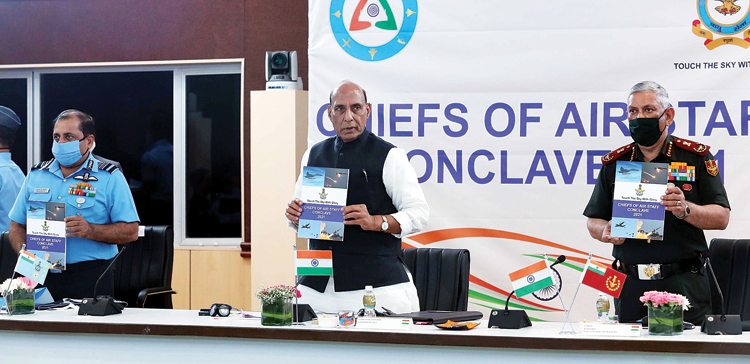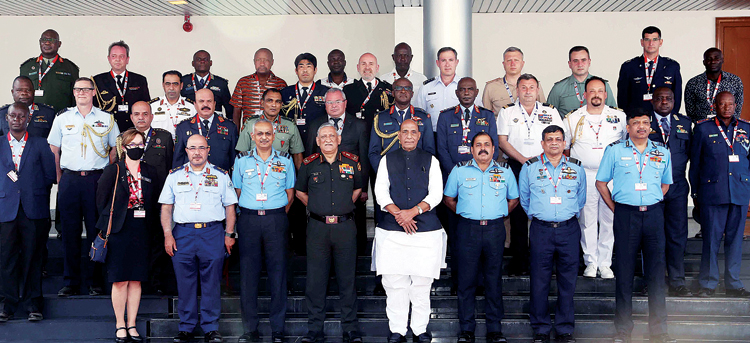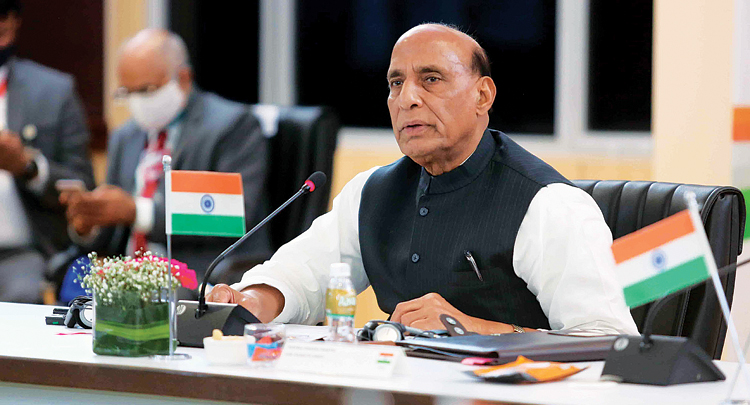- Prime Minister Narendra Modi inaugurates Aero India 2023 in Bengaluru; Releases Commemorative Stamp
- Defence Secretary meets delegations from Saudi Arabia, USA and Oman on the sidelines of Aero India 2023
- Foreign Ministers of 32 countries to attend Aero India 2023
- Embraer showcases the C-390 Millennium at Aero India 2023
IAF Chief calls for a Cooperative, Collaborative and Co-existing Air Power
Indian aerospace sector will truly come off age and emerge in the global aerospace supply chain, ensures IAF Chief R.K.S. Bhadauria, while calling for transformational and mutual advancements

The Chiefs of the Air Staff Conclave 2021 themed “Leveraging Aerospace Power for Security and Stability”, is organised by the Indian Air Force as part of the 13th edition of the Aero India exhibition. The conclave is spread across two days and consists of three key sessions focused around addressing disruptive technology and innovation, air power in Indo-Pacific region and, air power and aerospace strategies.
The conclave was inaugurated on Wednesday by Defence Minister Rajnath Singh in the presence of the Chief of Defence Staff, General Bipin Rawat, Air Chief Marshal Rakesh Kumar Singh Bhadauria and Chiefs and delegates from various countries. The conclave is aimed at discussing important issues with respect to strategies, emerging technologies, and their impact on future avenues in tapping global security and stability, a common goal of the participating countries of the Indo-Pacific region. The inaugural session witnessed 26 countries in physical participation and 14 virtually in line with the hybrid format of the Aero India 2021.
Air Marshal R.D. Mathur, Air Officer Commanding-in-Chief, Training Command, Indian Air Force welcomed the gathering stating, “For any air force, the strategic and the tactical are two sides of the same air power coin. We are all aware that modern air power assets can vary between strategic, operational or tactical effects sometimes all in a single sortie.” He also pointed to the considerable changes that have taken place in India’s neighborhood as well as the regional and global scenario.

Air Chief Marshal Bhadauria pointed out to the unprecedented challenges of uncertainty, volatility and common threat. “We have witnessed a paradigm change in the geopolitical landscape in the recent years, and globally, we are facing unprecedented levels of uncertainty, volatility and interconnected threats. While the world was grappling with complications and control of the pandemic, the worsening interstate relations, rising mistrust and geopolitical tensions have only reinforced the importance of a mature and balanced cooperation at international level. We need to strengthen our mutual understanding and existing security frameworks based on the principles of Cooperation, Collaboration and Coexistence. A very high degree of networked situational awareness for decision makers is required,” he said.
Bhadauria also highlighted the changing nature of warfare. “Advent of new technologies and cross linking of ‘Physical’, ‘Digital’ and ‘Cognitive’ domains has complicated the art of war fighting considerably. Also, the exponential technological progress made in the last few years has made the realm of sub-con warfare more complex. The low cost and easy availability of simple disruptive technology like drones with small state and non-state actors have made them more lethal, agile and capable of generating disproportionate effects,” he said pointing to the attack on Aramco oil refinery with armed drones, new drone technologies in the Syrian conflict and massed usage of Unmanned Aircraft System and loitering munitions in Armenia-Azerbaijan fight. He added that the IAF was closely observing these developments and working on capabilities in the unmanned and optionally manned platforms, manned-unmanned teaming and anti-drone technology.
He also talked about working more on public-private partnership models, and to not ignore the essence of software which has become as important as hardware. “Indian aerospace sector will truly come off age and emerge in the global aerospace supply chain. However, to retain edge in a highly diverse airspace, a very network centric approach for information sharing and partnership in combating cohesive activities should be looked at.”
Delving into IAF’s experience in building a potent Net Centric Warfare capability, he indicated that the military path further should be largely indigenous and noted IAF’s electronic Maintenance Management System (e-MMS) which has now become one of the world’s largest such systems with complete digital work flow environment across all platforms of the IAF, was developed by an Indian IT firm. Further he said that to deepen the HADR cooperation and coordination among neighbours, “we have also been conducting regular exercises with an aim to mutually share our expertise and assist in capability building. To enhance such interoperability further, we should look at establishing a methodology for sharing ISR grid when necessary.”

The defence minister underlined the impact and plans for self-reliance especially after the Prime Minister’s call for Atmanirbhar Bharat and the recent order of LCA Tejas being an important one in that direction. He said that the indigenous defence and aerospace industry of India has many success stories in the form of LCA, ALH and a host of defence weapons.
“A strong aerospace base is essential for India to become self-reliant as well as to support the need of the rapidly growing aviation sector within the country and in the neighborhood as well. The path breaking decision of increasing foreign direct investment (FDI) limit in defence manufacturing under automatic route from 49 per cent to 74 per cent as well as the recently issued Defence Acquisition Procedure 2020 have included necessary provisions to include FDI and enhance manufacturing hubs across India,” stated Singh.
Underling the indigenously designed, developed and manufactured LCA Mk-1A as a boost to the ‘Make in India’, he added that close to 500 indigenous design and production agencies are involved in the manufacture of the LCA. Speaking of the success stories of the indigenous defence industry he applauded the Defence Research and Development Organisation (DRDO) for testing 12 missile types spanning the spectrum of ranges and purposes in a matter of one and a half months. “The IAF has launched a major indigenisation drive for sustenance of all aircraft fleets and maintenance aspects, this will prove to be the growth engine for Indian’s domestic aerospace manufacturing capability,” he said.
The Defence Minister assured that India can take on the role of being the net security provider in the region adding that air power has and would continue to play a critical role in maintaining regional stability and peace in the region. Recalling Prime Minister Narendra Modi’s keynote address at ShangriLa Dialogue-2018, Singh said that the Prime Minister had articulated the key role of India’s Armed Forces in building partnerships in the Indo-Pacific region for peace and security, as well as humanitarian assistance and disaster relief and I further express the intention of the country to cooperate with defence partners in these niche technologies with focus on knowledge sharing and co-production.
“The country has reached an inflection point in domestic defence manufacturing and the trajectory from here on would only be upwards,” stated the Minister.





